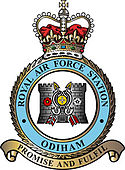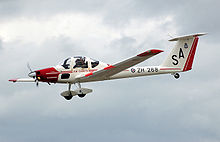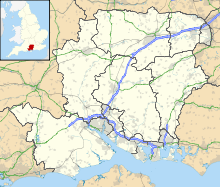- RAF Odiham
-
RAF Odiham 

Grob glider similar to that used by 618 VGS IATA: ODH – ICAO: EGVO Summary Airport type Military Operator Royal Air Force Location Odiham Elevation AMSL 405 ft / 123 m Coordinates 51°14′03″N 000°56′34″W / 51.23417°N 0.94278°W Map Location in Hampshire Runways Direction Length Surface ft m 10/28 6,052 1,838 Asphalt Approach 131.30 Mhz, Tower 122.1 Mhz RAF Odiham (IATA: ODH, ICAO: EGVO) is a Royal Air Force station situated a little to the south of the historic small village of Odiham in Hampshire, England. It is the home of the Royal Air Force's heavy lift helicopter, the Chinook HC2, HC2A and HC3. Its current station commander is Group Captain Shell OBE MA RAF.
Contents
History
Aircraft operations began from the site in 1925 but it was not until October 1937 that it was opened as a permanent airfield, ironically by Erhard Milch, then the Chief of Staff for the Luftwaffe.[1]
During World War Two P-51 Mustangs and Hawker Typhoons were flown out of the base. After the Allied invasion of Europe the site became a prisoner of war camp. Following the end of the War RAF Fighter Command assumed control of the base and operated Spitfires, Hunters and Javelins. No. 54 Squadron RAF moved in 1949, flying Vampires, before being reequipped with Meteors and being relocated to RAF Stradishall in 1959. As part of her coronation celebrations Queen Elizabeth II reviewed the Royal Air Force at Odiham in 1953.
After a short period in "care and maintenance" status the base was reopened as part of Transport Command. In this role Westland Whirlwind and then Bristol Belvedere helicopters were operated from the base. From 1961 to 1981 the Westland Wessex was based here, joined by the Puma of 33 Squadron and 230 Squadron in 1970.
In 1981 the Wessex helicopters of 72 Squadron moved to RAF Aldergrove, followed by 33 Squadron's Pumas in 1997 to RAF Benson.
Current role
The first Chinook HC.1s were delivered to the RAF in 1980 and arrived at Odiham in 1982. The first HC.2 arrived in 1993. The RAF ordered the Chinook HC.3, a special forces variant, in 1995. After being in storage for eight years due to avionics certification problems, the HC.3 airframes were retro-fitted with HC.2 avionics during 2009 and 2010, to enable them to finally enter RAF service.[1][2] In 2009, orders were placed for additional aircraft, but this is subject to the Strategic Defence Review due to be published in late 2010.[3] Additional aircraft are likely to be based at nearby RAF Benson.
618 VGS arrived in July 2000. The Unit operates the Vigilant T Mk 1. The Unit provides basic flying and gliding training to members of the Air Cadet Organisation. The Squadron operates normally at weekends and also runs four continuous week courses each year.
In 2010 it was announced that Surrey, Sussex and Hampshire Police would share Air Support. RAF Odiham will house one of two helicopters covering the three counties, the other being based in Shoreham in Sussex.
The Kestrel Gliding Club continues to fly from Odiham at weekends, having become part of the Royal Air Force Gliding and Soaring Association in 2006.
Resident units
- Headquarters, Joint Special Forces Aviation Wing
- 7 Squadron - 5 Chinook HC2. The 2 Gazelle AH.1 formerly operated by 7 Squadron have been re-assigned, XX385 into storage at RAF Shawbury and XZ296 to 666(V) Sqn at Netheravon.
- 18 Squadron
- 27 Squadron
- 18/27 (Engineering ) Squadron - Ground crew element of 18 and 27 Squadron, maintaining and repairing the 28 Chinook HC.2/2A and 8 HC.3 aircraft the flying squadrons operate
- Joint Helicopter Support Squadron
- No. 618 Volunteer Gliding Squadron - 4 Vigilant T Mk 1
- No. 657 Squadron Army Air Corps flying Lynx AH.7 helicopters (approximately 6)
- 2412 (Bordon and District) Odiham Detached Flight Air Training Corps
References
External links
- Airport information for EGVO at World Aero Data. Data current as of October 2006.
Categories:- Royal Air Force stations in Hampshire
- Airports in England
- Volunteer Gliding Squadron
Wikimedia Foundation. 2010.

